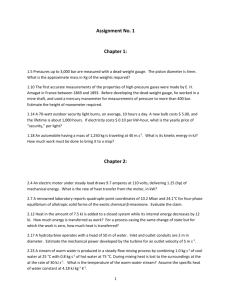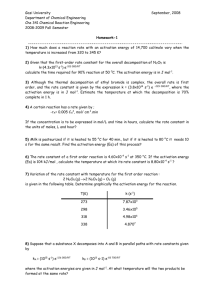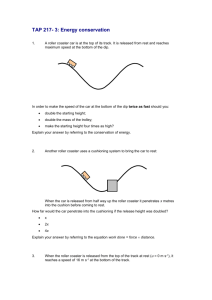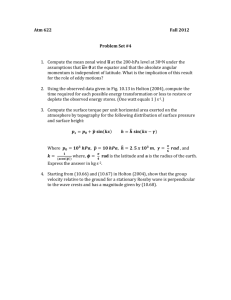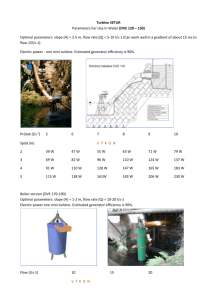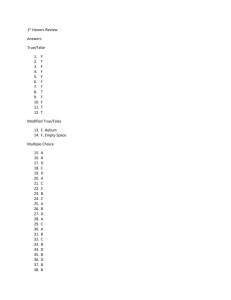THEORIES OF UNIMOLECULAR REACTION RATES
advertisement
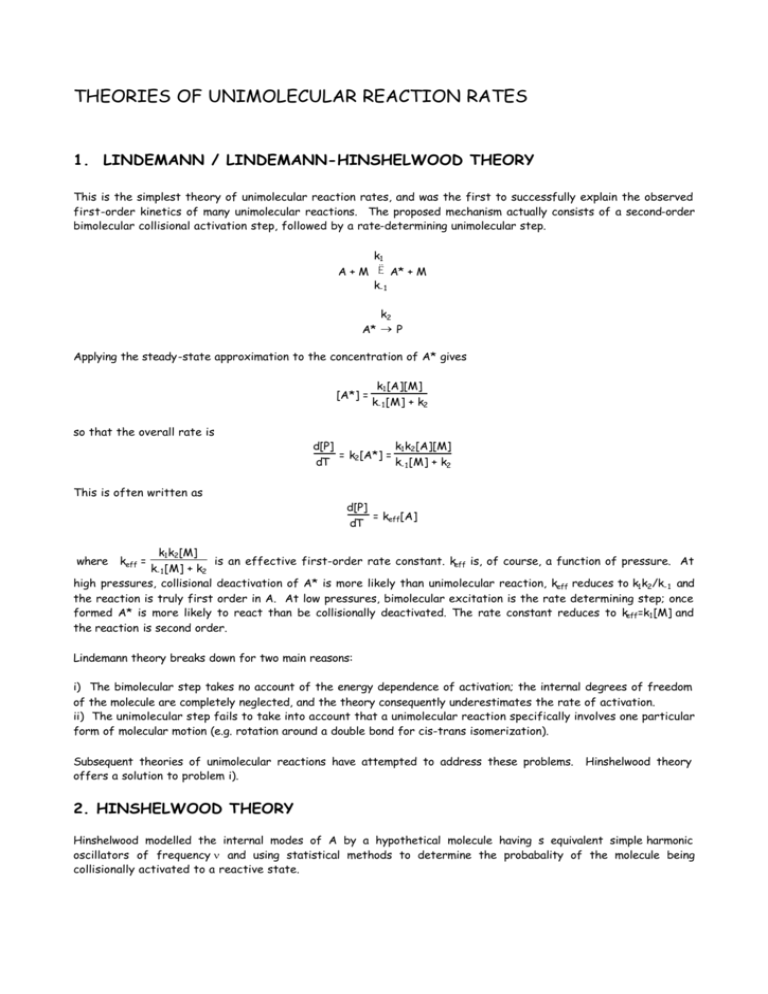
THEORIES OF UNIMOLECULAR REACTION RATES 1. LINDEMANN / LINDEMANN-HINSHELWOOD THEORY This is the simplest theory of unimolecular reaction rates, and was the first to successfully explain the observed first-order kinetics of many unimolecular reactions. The proposed mechanism actually consists of a second-order bimolecular collisional activation step, followed by a rate-determining unimolecular step. k1 A + M Ë A* + M k-1 k2 A* → P Applying the steady-state approximation to the concentration of A* gives [A*] = so that the overall rate is k1 [A][M] k-1 [M] + k2 d[P] k1 k2[A][M] = k2[A*] = dT k-1 [M] + k2 This is often written as d[P] = keff[A] dT k1 k2[M] is an effective first-order rate constant. keff is, of course, a function of pressure. At k-1 [M] + k2 high pressures, collisional deactivation of A* is more likely than unimolecular reaction, keff reduces to k1 k2/k-1 and the reaction is truly first order in A. At low pressures, bimolecular excitation is the rate determining step; once formed A* is more likely to react than be collisionally deactivated. The rate constant reduces to keff=k1 [M] and the reaction is second order. where keff = Lindemann theory breaks down for two main reasons: i) The bimolecular step takes no account of the energy dependence of activation; the internal degrees of freedom of the molecule are completely neglected, and the theory consequently underestimates the rate of activation. ii) The unimolecular step fails to take into account that a unimolecular reaction specifically involves one particular form of molecular motion (e.g. rotation around a double bond for cis-trans isomerization). Subsequent theories of unimolecular reactions have attempted to address these problems. offers a solution to problem i). Hinshelwood theory 2. HINSHELWOOD THEORY Hinshelwood modelled the internal modes of A by a hypothetical molecule having s equivalent simple harmonic oscillators of frequency ν and using statistical methods to determine the probabality of the molecule being collisionally activated to a reactive state. The number of ways of distributing a given number of quanta, v, among the s oscillators (i.e. the number of degenerate states of the system at an energy (v+½)hν) is (v+s-1)! gv = v!(s-1)! (a handwavy explanation of where this comes from is that (v+s-1)! is the number of permutations of all the quanta and all the harmonic oscillators. This has to be divided by the number of ways in which the quanta can be permuted amongst themselves, v!, and the number of ways the oscillators can be permuted amongst themselves, (s-1)!) The fraction of molecules in state v is given by the Boltzmann distribution nv gve-vhν/kT = N q where 1 q = -hν/kT 1-e 3 Hinshelwood now made the strong collision assumption. He assumed that the probability of deactivation of A* in any given collision is unity, so that the rate constant k-1 of the Lindemann mechanism is equal to the collision frequency Z. Because the collisions promote equilibrium, the probability of forming a state v in a collision is given by the Boltzmann distribution. The rate constant for activation to state v is therefore given by k1 v = Z gv e-vhν/kT q The overall rate of activation (i.e. rate of formation of collisionally excited A* with enough energy to react) is found by summing the k1 v over all the energy levels which can dissociate i.e. all levels with an energy greater than the critical energy E0 which the molecule needs to react. If the vibrational quantum number of the state with energy E0 is m, we have ∞ gv e-vhν/kT k1 = Σ Z q m The energies involved are usually large, with E0 >> hν. Hinshelwood developed equations for the case in which the energy levels can be assumed to be continuous (kT >> hν). The expression then becomes dk1 = Z N(E) e-E/kT dE q where N(E) is the density of states; N(E)dE is therefore the number of energy levels with energy between E and E+dE, and dk 1 is the rate constant for activation into this energy range. The total rate of activation is found by integrating dk 1 over all energies greater than the critical energy. s-1 Z E0 k1 = exp(-E0/kT) (s-1)! kT This differs from the simple collision theory rate constant, k2 = Z exp(-E 0/kT), by a factor of s-1 1 E0 (s-1)! kT , leading to an increased theoretical value of k1 . The increase is more pronounced for large molecules, which have more oscillators, and is exactly what is required to overcome the first failure of the Lindemann theory. 3. RRK THEORY Problem ii) can be addressed by recognising that a minimum amount of energy must be localised in specific modes of molecular motion in order for the unimolecular step to take place. A new step is added to the Lindemann mechanism, in which the generally excited molecule A* is converted into the specifically excited ‘activated complex’ A‡. k2a k‡ ‡ A* → A → P k‡ is of the order of a vibrational frequency, and k2a is generally much smaller. This means that conversion of A* to A‡ is rate determining, and k2a is the overall rate coefficient for conversion of A* to products. Because k2a << k‡, [A‡] is very small and we can use the steady state approximation to find k2a, giving k2a = k‡ [A‡] [A*] RRK theory assumes that energy can flow freely from one vibrational mode to another within the molecule (this is a fairly reasonable assumption, since molecular vibrations are highly anharmonic at chemical energies and are therefore coupled). As before in the discussion of the Hinshelwood theory, for a molecule with s equivalent (v+s-1)! oscillators, the degeneracy of the vth vibrational level is . If we have to locate at least m quanta in one v!(s-1)! particular mode for dissociation to occur (i.e. E0 = mhν), this simply reduces our choice of quanta to (v-m), and the (v-m+s-1)! total number of ways of arranging these is . The probability Pmv of locating at least m quanta out of v (v-m)!(s-1)! in the dissociation mode is the ratio of these two quantities. Pmv = (v-m+s-1)! v!(s-1)! (v-m+s-1)!v! = (v-m)!(s-1)! (v+s-1)! (v-m)!(v+s-1)! Because the quantum numbers involved are very large (i.e. v and m are >>s) we have (v-m+s-1)! → (v-m)s-1 (v-m)! v! → v-(s-1) (v+s-1)! and s-1 so that Pmv s-1 = (v-m) v -(s-1) v-m = v = (1- m/v)s-1 Since E=vhν and E0=mhν, this expression can be rewritten in terms of energies. E PE = (1 - E 0/E)s-1 0 E PE 0 is the probability of locating a minimum amount of energy E0 out of the total energy E in the dissociation mode. If energy randomisation takes place rapidly enough for the vibrational energy to be distributed [A‡] E E statistically, then = PE , and the rate constant is 0 [A*] E k2(E) = k‡(1 - E 0/E)s-1 k2 increases with energy, since the probability of localising a given amount of energy E0 in one particular mode increases as E increases. The localisation probability decreases as s increases since there are more modes to spread the energy across. Consequently, k2 becomes smaller as the molecule becomes more complex, in contrast to the behaviour of the rate constant for activation k1 . 4. RRKM THEORY Based on the results of Hinshelwood and RRK theory, the reaction mechanism can be rewritten to take account of the fact that the rates of collisional activation and unimolecular dissociation are energy dependent. A+M dk1 (E) Ë A*(E) + M k-1 k2(E) A*(E) → P Applying the steady state approximation to [A*(E)] leads to the rate expression d[P(E)] k2(E)dk1 (E)[A][M] = dt k-1 [M]+k2(E) from which we can identify the unimolecular rate coefficient for the energy range from E to E+dE as k(E) = k2(E)dk1 (E)[M] k-1 [M] + k2(E) The thermal rate coefficient is obtained by integrating over E from E0 to ∞ ∞ k= ∞ ⌠ k2(E)dk1(E)[M] = ⌠ k2(E)dk1(E)[M] . ⌡ k-1[M]+k2(E) ⌡k-1(1 + k2(E)/k-1[M]) E0 E0 In RRKM theory, the energy of the molecule is partitioned into fixed and non-fixed components. Only the nonfixed component E*, which can flow freely around the various modes of motion of the molecule, can contribute to reaction. The various terms of the rate expression are now evaluated using statistical mechanics. dk1 (E*) is the equilibrium constant for energization of the A molecules into the energy range E* to E*+dE*, and k-1 can be calculated from the partition function ratio QA*(E* )/Q A. i) ii) k2(E*) is obtained by applying the steady state treatment to the activated complex A‡ as in RRK theory, with the modification that the overall reaction is broken down into energy contributions from translation and from rotation/vibration. The rate constant k‡ and ratio of concentrations [A‡]/[A*] are evaluated using partition ‡ functions (k is treated as a translation along the reaction coordinate). In the high pressure limit, RRKM theory reduces to transition state theory. In the general case, RRKM theory admits equilibrium between A* and A‡, but not between A* and A. However, at high pressures A* and A are also in equilibrium. Transition state theory assumes that the activated complex A‡ is in thermal equilibrium with the reactants. This is equivalent to assuming that the thermal Boltzmann distribution is maintained at all energies, which is true at sufficiently high pressures ⇒ at high pressures the RRKM model becomes the same as the transition state theory model, and the results of the two theories coincide.
